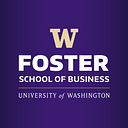Making Meaningful Connections: Insights from a Microsoft Sales Leader
Microsoft sales leader Bryan Tomlinson shares four strategies for effective networking with Foster School of Business MBA students
Written by: Gregory P. Heller, Foster School of Business Sr. Associate Director, MBA Career Management, with additional support from Leslie Meagley
Key Takeaways
Building a strong professional network isn’t about collecting LinkedIn connections — it’s about cultivating meaningful relationships through genuine engagement and strategic follow-through. Microsoft sales leader Bryan Tomlinson shares four strategies for effective networking:
Be Intentional: Approach each networking conversation with clear goals about what you want to learn and contribute, rather than just asking for a general career chat
Show Genuine Interest: Focus first on learning about the other person’s experiences and insights — being interested makes you interesting
Build Strategically: Aim to develop a few strong advocates rather than many surface-level connections, and maintain these relationships through regular, meaningful engagement
Follow Up Thoughtfully: Send specific, personalized follow-ups the same day as your conversation, and keep the relationship alive by sharing relevant articles and insights
In a recent conversation with Bryan Tomlinson, a Microsoft sales leader and Foster School of Business MBA alumnus, we explored the art of effective networking, relationship building, and interviewing. Drawing from his 14 years at Microsoft, Bryan shared valuable insights that can help MBA students navigate their career journeys more effectively.
The art of meaningful networking
Bryan emphasizes quality over quantity in networking approaches. “I try to take as many inbound requests as I can,” he says, “but those that are unique and specify exactly what they want to talk about get responded to first.”
When reaching out, he advises being clear about your objectives: “What do you want to learn? Some part of your plan might be, ‘I want to come out of this with this person being impressed by me,’ and that’s at least the start of a plan that’s pretty good. But also, what do you want to learn about that person? What do you want to learn about their role?”
His advice for making connections:
- Be specific about what you want to learn
- Show you’ve done your research
- Demonstrate genuine interest in the other person’s experience
- Plan your goals for the conversation
A common pitfall? Focusing too much on your own story. “It’s so hard to let your mind just drift,” Bryan explains, “but if I’m engaged, if I take the time to meet someone and have even a five-minute conversation… I want to learn about them.” He advocates for the principle that “interested is interesting” — engaging genuinely with others’ experiences often leads to more meaningful connections.
Building lasting professional relationships
Bryan outlines a strategic approach to relationship building, describing different levels of professional connections: “Think about your relationships can be in levels — step one’s just a contact we’ve met once. Then my next level might be someone that’s like a colleague, then it could be a mentor. And my last level is sponsor.”
He particularly emphasizes the importance of sponsors: “Sponsor level — I might have three of these honestly in my life. And a sponsor is: everywhere that person goes, to a new job or a new role, they’re going to try to find a job for me. Think about that — who are your sponsors in life, who you’ve gotten to that level with?”
On building these relationships, Bryan advises against a scattered approach: “The sort of shotgun approach where you just send out messages… it doesn’t work in this sense. You can’t keep that many people straight. You get to a point of like, ‘I have no idea who I even talked to.’”
Instead, he recommends a targeted strategy: “All you need is one person you know who will walk over and say, ‘Hey, I met this first year at Foster, and just take a look at the resume.’ That’s all you need. Do you have that person that can advocate for you?”
Mastering the follow-up
Timing and personalization are crucial in follow-up communications. “It’s got to be timely,” Bryan emphasizes. “Same day. And it’s got to be specific, like ‘Gregory, you and I talked about A, and I thought it was interesting because of B, and it would be good to learn more about C.’”
He also values ongoing engagement: “I love it when students share research or articles that I don’t have access to… even if it’s like, ‘Hey, I heard this one episode of this podcast, thought you might find it interesting.’ That shows me they’re trying to add some value back.”
For maintaining relationships, Bryan suggests: “I need to write this person every three to six months, send them an article that I read that I think was interesting, and try to build that into a real relationship.”
Final thoughts
Success in networking isn’t about perfecting a script or making hundreds of connections. As Bryan puts it, “You’re going to get a chance to give your pitch. You totally will. And if you haven’t by the end of a 30-minute conversation, it’s fair to say, ‘Hey, this was really great. Super quick before we end, let me just tell you a little bit about what I’m trying to do.’ That’s okay — don’t leave without it, but it’s okay if it comes at the end.”
Remember, every professional relationship starts somewhere. By approaching each interaction with genuine curiosity and a focus on building authentic connections, you can develop a network that not only advances your career but also enriches your professional journey. As Bryan reminds us, “Make an honest assessment after each call — some might be one and done, but others could become valuable long-term relationships.”
Learn more about the Foster School of Business MBA program here.
